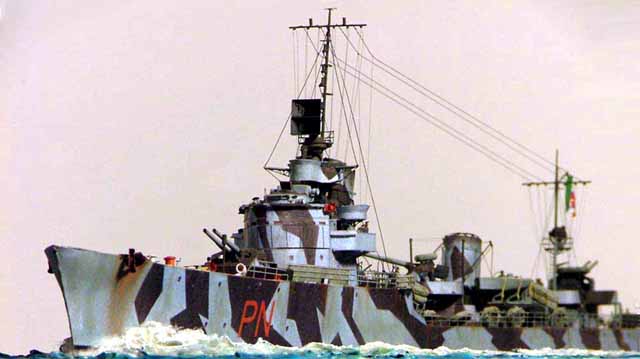by Luciano Lacqua

1/200 RN Leone Pancaldo (Dom Bumagi)

Leone Pancaldo was one of the 12 Navigatori class destroyers of the Regia Marina. Her namesake, Leon Pancaldo, was born in Savona in 1488 and accompanied Magellan in his expedition, redacting one of the two expedition's journals (the other was written by Antonio Pigafetta, an Italian navigator that would be commemorated by another ship of the same class) and later serving as skipper of the Trinidad.
Built by Cantieri Navali del Tirreno of Riva Trigoso, she was launched on 5 February 1929 and commissioned on 30 November of the same year. At the beginning of the war she was stationed at Taranto, assigned to the XVI destoyer flotilla that was to escort the IX battleship division; therefore, she was present at Punta Stilo on 9 July 1940, although not taking an active part in the engagement; the next day, while laying at anchor in the Augusta harbor, she was sunk by an aerial torpedo launched by a British Swordfish, with the loss of 11 men.
However, as she was laying upright at a depht of only 28 meters, it was decided to refloat her: this was accomplished after a year, by the use of flotation cylinders; this operation was also used as a cover-up for Xa MAS frogmen, that were being trained and 'hidden' amidst the divers working on Pancaldo.
Towed to Genoa for repairs, she received also an extensive upgrade: she was fitted with the most perfectioned sensor suit avaiable, comprising a sonar and a radar, an E.C.3/Ter "Gufo", and she underwent a radical rearrangement of her AA weapons: her after torpedo tubes were removed and in their emplacement went a platform for two single 37 mm Breda; also, nine 20 mm Breda were embarked and the aft funnel was lowered to widen their arcs of fire. Four Krupp DC throwers were installed on the aft deck, along with a pair of DC racks. Sporting a new splinter camouflage scheme, Pancaldo was recomissioned on 12 December 1942.
Resuming the troop transport runs bound to Tunis, Pancaldo served on some of those missions in the company of other destroyers before being attacked, on the morning of 30 July 1943, by a flight of about thirty P 40 fighter-bombers of the USAAF. Struck by many bombs, she sank bringing with her 156 men.
This was for me an attempt to see if a paper model could get near the quality level we're used to expect from a plastic kit; so I chose this model from the small but enterprising russian producer Dom Bumagi. It's really a misterious model in some respects: generally very accurate, it must have been thorougly researched, but it has some curious faults nonetheless, such as the light gray colour that, on the original sheets, had a weird violet shade.
So the first thing I did was to scan all the sheets and to correct the colours with photoshop; unfortunately, the light gray I got at my printer was too charged in blue, while the real grigio cenerino chiaro was more neutral. Just so you know...
Planning the work, I chose to build the model waterlined, as the lower hull is often poorly rendered in paper; I also bought all the accessories that were avaiable for this model, all from GPM: a PE set, turned barrels and a set of life rafts. Railings came from L'Arsenal.
The construction in itself had nothing of particularly difficult, it's a sort of relaxed scratchbuilding; I just had to provide some copper wire and various Evergreen rods to build masts, steam piping, torpedoes and DCs. The GPM PE set, although not always resolutive, was fundamental for some details like the radar and spared me a lot of tedious work for a whealt of smaller bits. What was really difficult was to find a bluish gray paint that could match the printed gray: I obtained this by mixing some acrylic paints, while for dark gray I had an Humbrol enamel that matched exactly.
The scale was big enough to add a crew: I then purchased a box of 1/200 assorted figures from Preiser, and enlisted the civilians in the Navy by glueing a roundel of paper on their heads (but I left some of them barehead as well). Their variety of poses allowed me to put some of them at work, and others at rest.
Rigging was done with stretched sprue and fishing line; wheathering was entirely done with pastels.
I did the seascape with plaster and cotton, painting all this by airbrushing all the light blue acryilics that I found on my desk.
The finished model will soon be enclosed in a plexiglass case.
